Industry-Sponsored Student Capstone Projects
2023/2024
In the 2023/24 academic year, the industry capstone program was supported by 54 sponsors, more than half of which were returning, and 95 real-world projects. Over 550 students from across the College of Engineering participated. Scroll down to learn more about each project.
PATH
Improved Water Quality Testing Kit
How do you know if the water you drink is safe? If you went to a hospital or clinic, would you be worried the water you drink could make you sick? Did you know that 25% of healthcare facilities worldwide don’t have water onsite? And that contaminated water—found in 25% to 57% of water samples in HCFs in Rwanda, Tanzania, and Uganda health facilities—contributes to the spread of infections, particularly among vulnerable patient populations, such as mothers and infants? Water monitoring is a challenge globally – commercial sensors are expensive and often give users more information than they need, making them overcomplicated. DIY components are more accessible. PATH is a global team of innovators working to accelerate health equity so all people and communities can thrive. PATH advises and partners with public institutions, businesses, grassroots groups, and investors to solve the world’s most pressing health challenges. The PATH team involved in this project focuses on using a human centered design approach to bring clean and safe drinking water to health care facilities in low and middle income countries. As the climate changes, clean drinking water will become more and more of a challenge and this HCDE student team worked to potentially help improve lives through this capstone. This student team's project purpose was to think creatively about how to better monitor water quality – building on existing technologies, software, and approaches to specifically assess chlorine levels in water through affordable, reliable, and user-designed approaches. The student team considered HCDE factors such as communication of scientific data, digital device design, and user interface design. The students also worked to develop and use general engineering skills for device design and prototyping (coding, 3D printing, etc.) and worked with global leaders in the sector, while gaining practical, hands-on experience. The outcomes this student team worked to achieve include User Research, Design Research, Ideation, Prototyping, Evaluation The student team worked to create a prototype and final devices for testing water quality in an affordable and easy-to-use way. They worked to include such aspects as physical products, digital files, design documentation, and user instructions. Students also worked to create documents including product and user requirements, brainstorming records, study designs, data collection templates, and final presentation materials such as reports and posters.
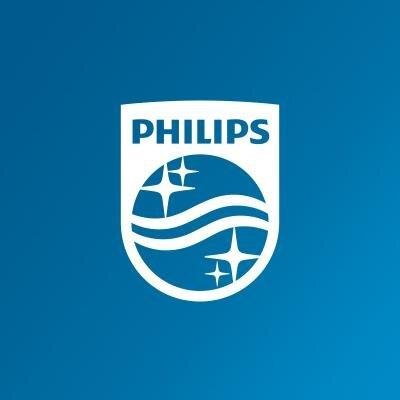
Philips
Automatic Detection of Pediatric Patient for AED Application
Current Automated External Defibrillators (AEDs) have buttons or keys that the responder needs to invoke when the AED is attached to a pediatric patient (defined as < 25 kg). The button/key configures the AED so that the energy delivered is reduced to a level optimized for a pediatric patient. In some AEDs, the button/key also changes the algorithm that determines shock/no shock so adjustments are made for pediatric changes in ECG. The button/key also induces further configuration changes to the AEDs CPR instructions to accommodate pediatric patients (e.g., changes in compression depth for smaller patients). In some geographies, compressions are preferred over immediate defibrillation for pediatric patients and this may also be adjusted. It is often difficult for lay responders (non-professionals) to correctly identify pediatric patients. AEDs typically do not require knowledge of exact weight and actually state not to delay treatment for the exact weight determination. While current AEDs initiate a voice prompt when a button/key is invoked stating "pediatric patient," the voice prompt states "adult patient" if the button/key is removed. In a cardiac arrest emergency, it is difficult for a responder to remember to use the available button/key or to know if the patient is pediatric (25kg). Although pediatric cardiac arrest is rare compared to adults, this is a significant issue with impact on patients as well as responders. This student team worked to identify a solution to easily measure patient size or otherwise identify a pediatric patient. Potential solutions for mobile AEDs this student team worked to consider included identifying situational characteristics that suggest a pediatric rescue may be needed, such as an automatic identification of a scene where a pediatric patient may be more likely (e.g., summer camp, swimming pool). The student team also worked to consider a voice prompt that would only be issued during certain scenarios - so as not to slow down the rescue or confuse the responder - but that would prompt the user to consider pediatric mode. The solutions the student team worked to provide had to be easy to use and not delay treatment. The solutions also needed to minimize any situation where pediatric therapy is administered to an adult. Since most cardiac arrests are adults, the solution could not impair care for adults. The student team also worked to explore opportunities for further user testing, IP development, and commercialization. The student team worked to test the prototype for implementation, ease of use, risks to patient care and cost.
PSC Consulting
Identifying and Estimating Behind the Meter PV Capacity on a Feeder Using Machine Learning
The amount of Behind the Meter (BTM) generation may not be known to utilities. With increased penetration of rooftop solar, can PSC Consulting come up with estimates of solar power generation in a neighborhood or on a feeder? Recognizing solar panels from satellite imagery seems to be well-understood and well-defined. This student team will work to go through a learning exercise of combining the knowledge of recognizing solar panels from satellite imagery with other publicly available or utility provided information (e.g. address of the unit, approximate KW, connected feeder, scrape information from permits of the city or county or utility). This student team will also work to understand current regulations, data challenges, etc. - This student team will work to find and download Puget Sound metro area aerial images of roof-tops, process them with a program, and identify houses with solar panels. - This student team will also work to estimate the capacity of those panels. - This student team will work to determine the nearest feeder - This student team will work to aggregate solar generation capacity on those feeder(s). The outcomes this student team is working toward are 1) a technical paper submission and acceptance by IEEE Power & Energy Society or similar entity and 2) the usual university/department requirements.
Puget Sound Energy (PSE)
Substation Capacitor Bank Sizing Tool
This student team will work to evaluate the sizing, operation, and coordination of substation capacitor banks on PSE’s distribution system. With the drive toward renewable energy and electrification, understanding how to approach reactive power flow on the distribution system is a complex problem to solve. Changing load and generation types, including Electric Vehicles, Data Centers, Solar Generation, and Energy Storage provide both a challenge and opportunity for PSE to appropriately plan for reactive power flow. This student team will work to help PSE identify how Substation Capacitor banks, as one piece of the distribution power system, can effectively coordinate to provide reactive power support. This student team will work to develop specific design parameters and performance criteria as part of the project. The scope of work includes planning, control, and operation of substation capacitor banks. This student team will work to document existing operational procedures and recommend improvements and appropriate sizing of capacitor banks in substations via an Excel-based tool. Additionally, the student team will work to create a tool that includes consideration of other reactive components on the system, such as inverter based resources, line capacitors, and transformer LTC. The desired outcomes this student team will work to achieve are a detailed understanding of current capacitor bank operational approach and the identification and recommendation of future opportunities for improvement. This student team will work to provide a summary report and Excel-based tool that provides recommendations to PSE on appropriate sizing and operation of substation capacitor banks.

Snohomish County
Enterprise Scanning Center Workflow Analysis
The county has an Enterprise Scanning Center within the Department of Information Technology. The scanning center provides scanning and imaging services to over 28 departments in the County with over 3,800 employees. The team consists of 8 imaging technicians and project coordinators as well as 1 supervisor. In 2022, the scanning center processed over 1,665,000 images. Several departments have invested hundreds of thousands of dollars in external imaging services from outside vendors in order to complete large projects that the Enterprise Scanning Center could not accommodate. In order to better serve the departments in the county, this student team will work with IT to conduct an analysis of current scanning center operations with the goal of increasing the output without negatively impacting quality control. This student team will work to: -Assess the maturity of Enterprise Scanning Center processes. This includes evaluation of employee processes and document conversion processes. - Analyze outputs by types of files. - Collect and evaluate improvements of inputs/outputs, employee and customer satisfaction, and efficiency gains (time, materials, hardware/software costs, etc.) - Analyze processes including: - Physical movement - Document preparation - Scanning hardware/software - QC (quality control) processes (e.g. page-by-page vs at-a-glance) This student team will work to identify and eliminate sources of waste in workflow processes. This student team will also work to understand software/hardware needs, and identify opportunities for software/hardware upgrades. This student team will work to increase volume of image processing near, or equal to, industry standards. Finally, this student team will work to create a system for routine periodic review of systems, processes, and technologies.

Sony
Connecting Sony Products
Sony has a wide portfolio of products that fulfill a wide variety of needs. This student team worked to create relationships between different Sony products, which required the student team to think beyond use cases for gaming, audio, and TV. The student team worked to focus on TV though they were not limited just to TV, they also took into consideration home theater products, mobile audio products, IoT devices, and Sony cameras. This student team worked to identify solutions that made sense on Sony products as well as on mobile applications. Outcomes this student team worked to achieve include: -Use cases or frameworks -A final report and presentation -Notes
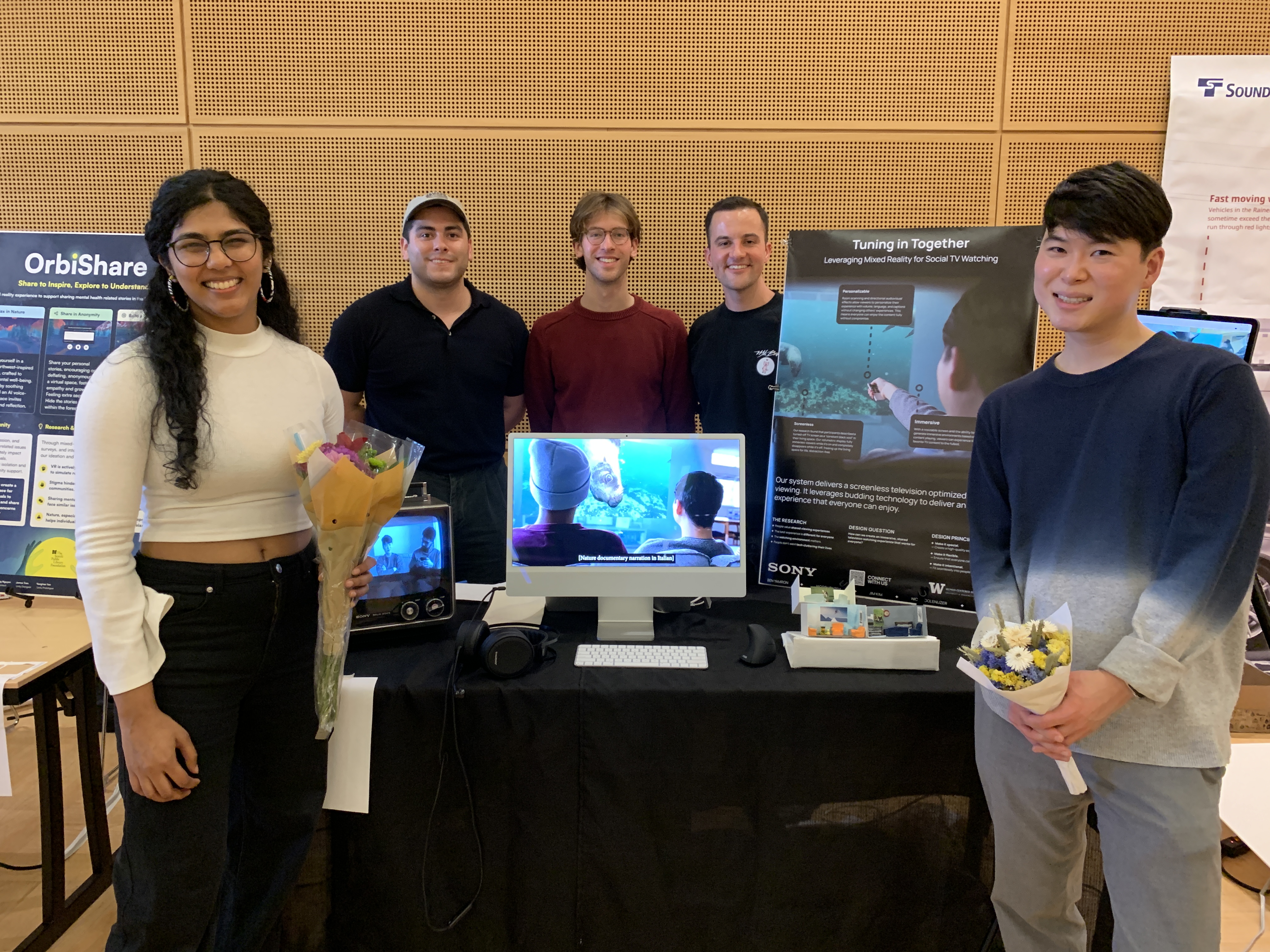
Sony
Rethinking spatial and augmented reality for TV
This student team worked in three groups to explore augmented/spatial reality space and trends for TV. This student team worked to explore how Sony can push the next generation of TVs or home entertainment products within these spaces. This student team worked to include the role of 360 video for Sony products in their considerations. This student team worked to focus on augmented or spatial reality TV/products. This student team focused on TV, but also considered home theatre products, mobile audio products, IoT devices, and Sony cameras. This student team worked to emphasize solutions that made sense on Sony products, not just mobile applications. Outcomes this student team worked to achieve include: - Use cases or frameworks -Final report and presentation -Notes
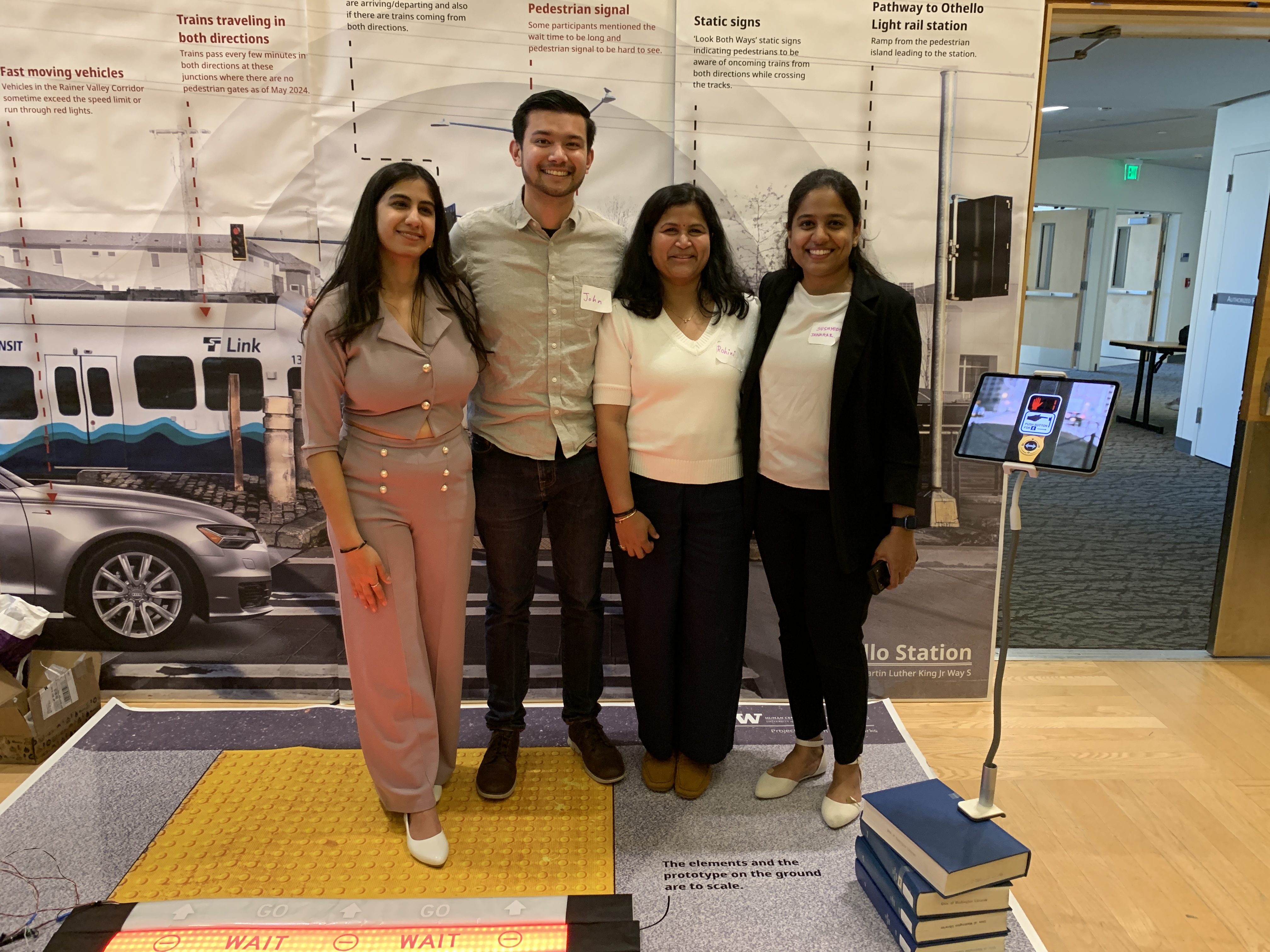
Sound Transit
Eye-Tracking: At-Grade Crossing Safety
Sound Transit has been investigating system-wide strategies to enhance the safety of at-grade crossings, which are any location where a road or pedestrian pathway crosses the rail tracks. This student team worked closely with Sound Transit to thoroughly evaluate existing design and placement of Link light rail signage in the Rainier Valley Corridor and applied innovative research methodologies (e.g., eye-tracking) to understand passenger/pedestrian behavior. Students also worked to draw upon secondary research from peer agencies and best practices to build an understanding of industry best practices of at-grade crossings. Students worked to build the domain specific knowledge and to utilize UX and Human Factors research and design principles to brainstorm, prototype, and validate a solution to enhance safety at at-grade crossings. The designed solution this student team worked to consider included the following requirements: - Built on an understanding of real-world users needs and challenges - Comprehensible to people from different cultural backgrounds and with different levels of English proficiency - Works for users with different mobility impairments and physical disabilities - Closely follows human factors and user-centered design principles to design the best experience The deliverables this student team worked to achieve include: - Research documentation, summaries, actionable insights, and recommendations - Secondary research: Heuristic evaluation of MUTCD standards and the current state of at-grade crossing features; review of industry best practices, peer agencies, and related literature; UX and human factors evaluation - Primary research: Qualitative studies, building persona and journey map, and conducting eye-tracking research at at-grade crossings - Design enhancement ideas, validation research report, and final presentation - Prototyping: Design and prototype enhancement ideas - Design validation: User testing (including eye-tracking studies), iteration, and recommend a final design
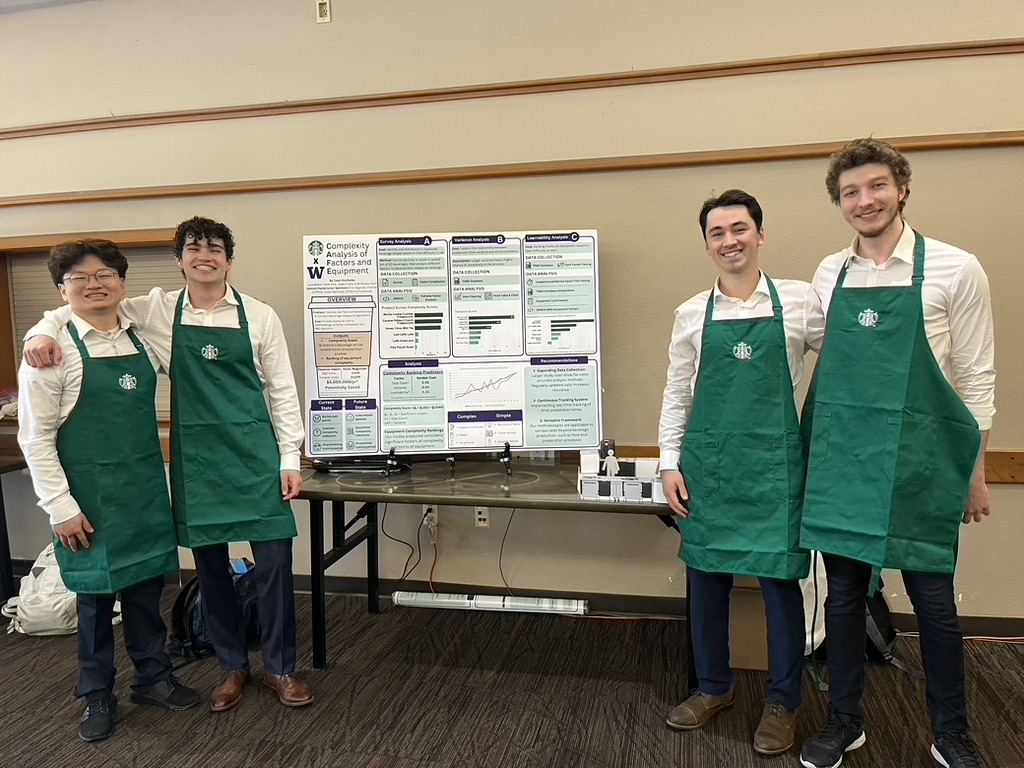
Starbucks
It's Complicated - Complexity Calculator
At the heart of Starbucks is a passion for coffee and a drive to reimagine the coffee experience – for Starbucks' partners (employees), their customers, and the environment. Whether it’s imaginative beverages, advancements in store design, or improvements in technology, innovation is at their core helping push the company in new directions. From how someone orders to how Starbucks brews and more, they're obsessed with finding the newest ways to make things better and easier for their partners and customers. But how does Starbucks know if they're on the right path? How does Starbucks know if they are making things better and easier? The missing link, Starbucks thinks, is a defined methodology for measuring complexity for all types of innovation (products, equipment, systems, etc.) to better inform business decisions and project prioritization. This student team will work to create an objective method for determining/assigning complexity factors to products, equipment, and systems at Starbucks. The method should be applicable to both the physical and non-physical. The deliverable this student team will work to achieve is a repeatable and objective method for defining and calculating complexity at Starbucks. The method this student team will work to create should be able to be used as a standalone factor that can be compared to productivity changes in a product/process/etc. to help Starbucks make more holistic business decisions that keeps the wellbeing of baristas and customers at the core of everything they do.
T-Mobile
3D RF Coverage Mapping Using Aerial Drone Data
Background: - Radio Frequency (RF) coverage mapping is crucial for optimizing the performance of wireless networks, managing interference, and ensuring robust connectivity - Traditional methods of RF data collection and coverage mapping can be resource-intensive and may not provide a comprehensive three-dimensional view of the RF environment necessary for testing massive MIMO and higher frequency bands - Placement of outdoor home internet devices by T-Mobile customers is non-intuitive and requires professional installation in most cases. Our approach is to use 3D maps to intelligently pre-select best location for customer and minimize installation costs. - Implementing drone technology can potentially enhance data collection capabilities and provide intricate 3D RF coverage maps This student team will work to develop a drone-assisted testing methodology to collect RF data and build an application to visualize this data creating a comprehensive 3D RF coverage map. The map this student team is working to create will be validated against 3D prediction models and apply machine learning to predict optimal locations for outdoor home internet devices. The RF Data Collection & Analysis this student team will work to collect and provide includes: - Data Acquisition: Utilize advanced logging tools for RF data capture - Drone Flight Plan: Plan and design flight plans for thorough data collection - Data Processing: Analyze RF data for signal strength, noise, beam pattern and other performance metrics. - Network Analysis: Identify and evaluate dead zones, interference, and signal strengths for future enhancements For the 3D Coverage Map, this student team will work to provide: - Application Development: Create a user-friendly application for visualizing 3D RF maps - Data Visualization: Process large datasets to generate accurate 3D RF maps - RF Model Validation: Validate and refine existing coverage prediction models - Home Internet Device Placement: Use machine learning to predict optimal home internet device placement The outcomes this student team will work toward includes: - Enhanced testing capability with drone-assisted 3D RF data to improve network performance - Enable outdoor home internet solutions with optimal device placement predictions - Reduce carbon footprint and operational expenses compared to traditional testing methods The deliverables this student team will work to provide include: - An application capable of generating detailed 3D RF coverage maps using drone-assisted RF data - Comparison with existing 3D RF propagation models - ML model to predict optimal CPE device placement based on 3D RF data - Presentation to T-Mobile leadership with findings, impact, and future recommendations - Final report and poster presentation showcasing UW Capstone project results

TE Connectivity
AI-Aided Expander Machine Parameter Optimization
The Automation Manufacturing Technology (AMT) team is looking for an automated method to adjust parameters for one of our medical manufacturing machines using a closed loop system assisted by a machine learning model. This student team will work to optimize the air flow to create the ideal air pressure based on different variables which would improve machine efficiency and minimize production costs. Some of the factors that affect desired air pressure include outer diameter, surface quality, and the length of product that has already been processed. This student team will work to receive data and develop an optimized air flow model with air pressure being the output. The outcome of this project can be implemented in manufacturing equipment for medical devices. Currently the air pressure is an offline parameter that operators manually adjust. Two of the independent variables this student team should work to consider in this system include outer diameter of the tubing, surface texture. This student team will work to provide the optimized air flow rate for each combination of these variables such that the air pressure is constantly increasing based on the length of the product that has been processed by the machine. In addition to this main scope, this student team can work to automate other parameters. The outcome this student team will work to create is an optimization program where the user can provide inputs in an easy excel type format and the outputs of the airflow rate will be in an excel or similar format (Need to confirm). The program should accurately predict the optimized air flow based on the input data. A stretch goal the student team could work toward is the integration of the solution into the manufacturing line.
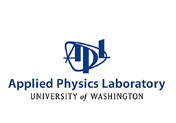
UW Applied Physics Laboratory (APL)
Track Foraging Bats in the Union Bay Natural Area
This student team will work to build ultrasonic microphone arrays to track foraging bats in the Union Bay Natural Area (UBNA) that is immediately adjacent to the UW campus. Bats are an important ecosystem indicator, and their biological sonar system continues to inspire engineers in adaptive sensing designs. Data collected in the UBNA using low-cost single microphone recorders since 2021 has shown stable bat activities in the UBNA in May to early October. In particular, in the call sequences frequent foraging events are observed that simultaneously involve multiple bat individuals or species. By working to deploy microphone arrays in the UBNA, this student team will work to open the door for understanding the rich behavioral repertoire of foraging bats as they interact with their prey and each other through both sounds and movements; it is possible that engineering inspiration for sonar-guided autonomous sensing may be drawn from the results accomplished with this project. Bats in the UBNA emit echolocation calls in the ultrasonic frequency range (25-80 kHz; with three major groups: 25-35 kHz, 30-40 kHz, and 40-80 kHz). In this frequency range sounds are subject to strong absorption. In addition, bat echolocation calls are directional, with the beampattern dynamically modulated depending on the foraging context (e.g., distance to prey, prey type) and the environment. In general, the higher the frequency, the stronger the air absorption, and the more directional the sonar beam. These factors in combination limit the effective spatial span of a microphone array, even though a longer baseline is typically favorable for source localization. The microphone array this student team will work to develop through this project should be able to track bats in all three frequency groups and should be easily deployable by a two-person team in the UBNA field condition. The array should be able to operate autonomously, with configurable on-off cycles, the capability to collect full-bandwidth data for post-analysis, and a minimum length of continuous operation of 12 hours. The outcomes this student team will work to accomplish include: -- Microphone arrays (2-3, depending on material cost), operating software, design diagrams and code documentation -- Recording from lab and field testing -- Implementation of tracking algorithms (optional, but this will be super cool to see!)
UW CoMotion
In the Slot – Umpire Training Tool
The Umpire Perspective Training Tool is a system (hardware and software) that would allow for umpire strike zone evaluations to be done from the umpire’s perspective. Currently, all training is done using baseballs on a stick at slow speeds or outside the field evaluations by trainers. There is no tool available for umpires to learn the strike zone from their personal perspective. While there are numerous studies and publications discussing the batter's perspective, there are are no equivalent analyses for umpires (See Journal of Experimental Psychology: Human Perception and Performance. 1993, Vol. 19, No. 1, 3-14 for an example). This student team will work to create a training system to be used off-line and not an instant ball/strike indicator. The student team will work to create a set of glasses (not AR/VR headset) that fits under the mask that can record pitches using a simulated batter but live pitching. Seasoned umpires agree that a camera mounted on top of the umpire's head does not capture what they see during a pitch. After the session, the recording would be downloaded and run through ML/AI to determine for each pitch: bottom of zone, top of zone, and projected plate volume which the ball travels through. A tally of balls and strikes as well as a graphic showing the umpire’s bias (e.g., low strikes, outside corner etc.) could then be shown and pitches with the plate volume overlay could be reviewed. This visualization would be used as a teaching tool between trainer and student umpire. The student team could also work to collect other data, such as head movement and positioning. The design parameters this student team will work to incorporate include: * High School and above baseball field dimensions for home plate, batter's box, and pitcher's mound * 60 - 90 mph fastball using a standard baseball traveling through the strike one * Data collection device which fits within the standard gear a home plate umpire wears and does not interfere with typical umpire mechanics * Strike definition is can be adjusted according the level of play (e.g., Little League, MLB, etc.) and batter * Software analysis tool can visually display calculated strike zone overlay The outcomes this student team will work to achieve are: 1) Determine the video capture rate and equipment required to collect data during a strike zone training session; 2) Develop a prototype ML/AI system for data analysis that correctly calculates the strike zone for a given batter and can display where the pitch intersected the strike zone volume; 3) A recommended device design criteria and 3D model of a the proposed final device; 4) Recommendations for next steps; and most importantly 5) Have fun and be challenged.
UW Electrical and Computer Engineering Quantum Technologies Training and Testbed lab (QT3 Lab)
Embedded Subsystem for Atom Detection in a Quantum Computer Testbed
The quantum technologies training and testbed lab, located in the electrical and computer engineering department, is building a quantum computer testbed based on neutral atoms trapped in optical tweezers. Atoms will be trapped in a pre-defined array of optical tweezers in the focal plane of an in-vacuum microscope objective and then detected on an EMCCD camera via fluorescence imaging. Depending on the quantum state of these atoms, they will either fluoresce or not. This student team will work to determine which atoms are fluorescing in as little time as possible. By developing an embedded system within the ARTIQ open-source FPGA framework, using the Camera Link protocol and dedicated subsystems for image processing, this student team will work to design, implement, and test a subsystem for atom detection for the quantum computer testbed. This student team will also work to design a programmable "mock atom array" to test this imaging subsystem based on off-the-shelf optical components and a microdisplay. The design parameters this student team will work to include are the configurable properties of the Camera Link interface, atomic fluorescence rate, imaging system optical design parameters. Key performance indicators for this subsystem are detection fidelity and detection time. This student team will work to design, build, and test this new subsystem within the context of the ARTIQ open-source FGPA hardware framework. Outcomes this student team will work to achieve include: 1. Demonstration of EMCCD camera control and data acquisition over camera link interface connected to the artiq 2. A subsystem architecture compatible with the ARTIQ framework - the main choice here being how to handle image processing to minimize timing overhead. 3. Design and build the imaging subsystem and micro-display based test fixture. 4. Test, provide a report that details the performance of the system, design factors that limit performance, and tradeoffs.
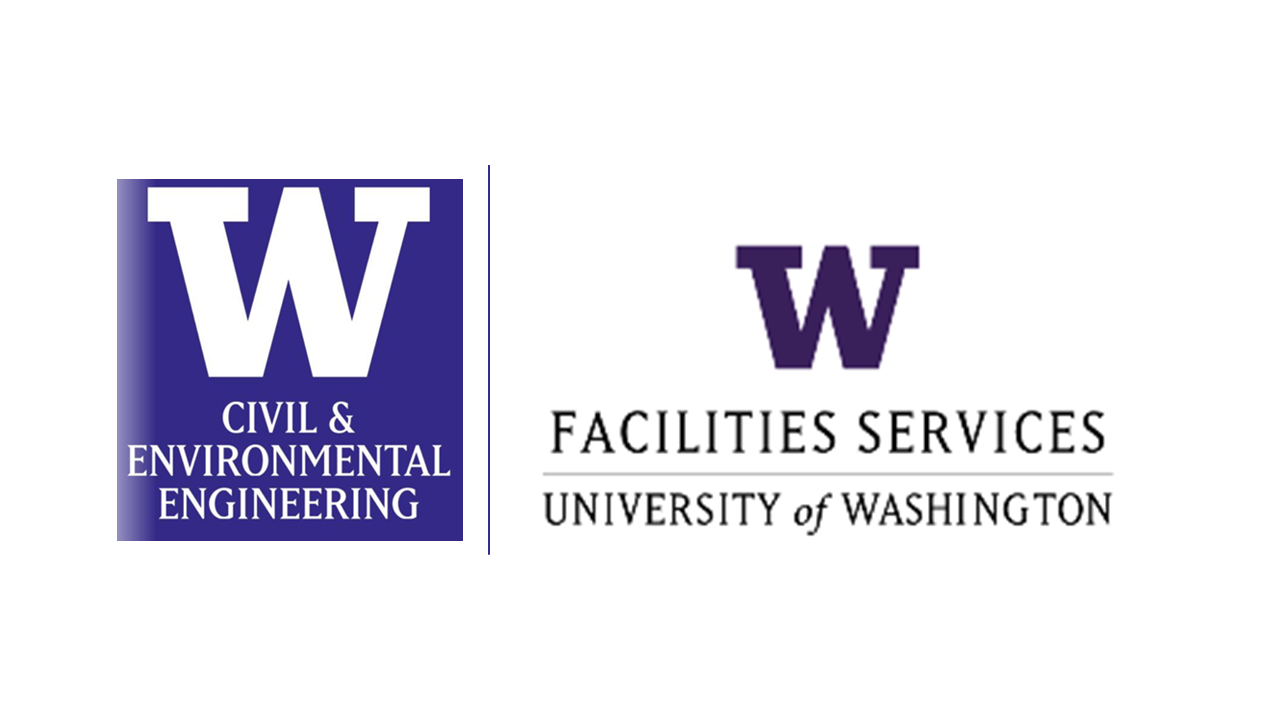
UW Facilities and Department of Civil and Environmental Engineering
Piloting a Precision Landscape Irrigation Advisory System
University of Washington (Facilities) has to spend significant financial resources to efficiently manage the irrigation of campus landscape in Seattle during the months of summer and long periods of no precipitation. There is currently a smart irrigation idea that has been developed and implemented in developing nations based on satellite sensor data and internet of things (IoT). This concept has been piloted in India and the idea is well developed. However, the concept has not been fully calibrated and tested as an operational product for a user. In this Industry capstone, the student team will work to apply the same IoT concept to identify at timescales of daily to weekly the spots/regions on UW campus that need more urgent irrigation than others, thereby minimizing significant amounts of unnecessary irrigation and operational cost. The concept will use, as a baseline, a coarser scale and fully satellite/model based system called Integrated Rice Advisory System (IRAS; see http://depts.washington.edu/saswe/dae) that uses NASA Landsat/MODIS Thermal Infrared Data at 60-100 meter scale, NASA Global Precipitation Measurement (GPM) mission data at kilometer and NOAA Global Forecasting System (GFS) weather forecast data at kilometer scale. The scripts and tools for the fully satellite-based system are fully developed in user-ready format and have already been scaled, tested and currently are in mass use by governments of Pakistan and Bangladesh serving millions of farmers. A PhD-level UW graduate student from the PI’s research group – SASWE (www.saswe.net) will be available to provide training on IRAS and to mentor the student team. In Winter 2024 this student team will work to understand the fully satellite-based system and ways to customize it as an online dashboard for UW campus landscape. At the same time, this student team will work to install in-situ IoT sensors that measure soil moisture and air temperature at canopy level throughout the campus. WIN 2024 TASKS: #1 - Understand existing IRAS system in operation in Pakistan and Bangladesh; #2 - Understand the concept of IoT-based system piloted in India (called PANI); #3- Set up in-situ IoT sensors on soil moisture and temperature; #4- Customize the IRAS tool for UW campus for variety of plants (non-rice). In Spring 2024 the student team will work to integrate IoT data with the satellite-based coarser-scale irrigation system to downscale the information at hyperlocal plot scale. Spring 2024 TASKS: #5- Integrate IoT data into the satellite irrigation tool set up for UW campus to generate hyper-location information on irrigation status #6 – Assess the hyper local information’s quality #7 – Develop the online dashboard providing weekly to sub-weekly updates on irrigation status of UW landscape. The final deliverable of this project will be an online dashboard hosted at http://depts.washington.edu/saswe/ that will run during the months of summer (June to Sept) from 2024 for UW (Facilities) and that updates at weekly or sub-weekly timescales the irrigation status of UW campus landscape using satellites and IoT sensors. The intended goal the students are helping the organization achieve is to take advantage of in pilot mode in minimizing unnecessary irrigation and optimizing their irrigation schedules. FINAL DELIVERABLE DATE: June 15 2024 With minimum cloud cover and campus wide wi-fi, and 8 years of research and application into the satellite-based system in South Asia, we expect the proposed capstone project to be low risk – high payoff for University of Washington and for future clients and investors. At a minimum we expect to showcase the technology and share lessons learned (in terms of what worked and what did not; future work) with PEPSI CO and SoilTech Center’s Industry Advisory Board.
Related News

Fri, 09/20/2024 | UW Civil & Environmental Engineering
Smarter irrigation for a greener UW
A new project combines satellite data with ground sensors to conserve water and create a more sustainable campus environment.
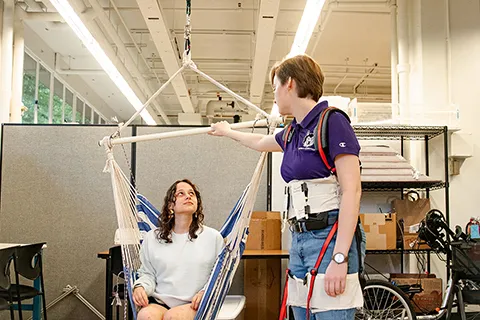
Mon, 09/09/2024 | UW Mechanical Engineering
Testing an in-home mobility system
Through innovative capstone projects, engineering students worked with community members on an adaptable mobility system.
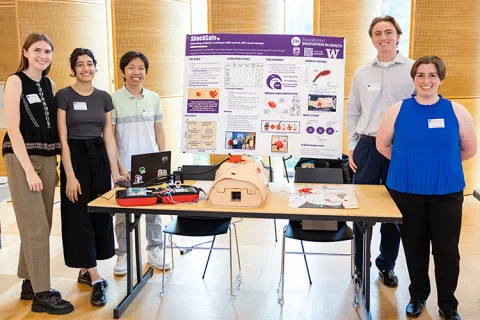
Mon, 08/19/2024 | UW Mechanical Engineering
Students strive to ensure accurate AED shock dosage
ShockSafe, developed by students with the help of mentors from Philips and Engineering Innovation in Health (EIH), can distinguish between children and adults during cardiac arrest emergencies.

Wed, 08/07/2024 | Snohomish County News
Snohomish County, University of Washington partnership boosts efficiency in enterprise scanning center
UW Industrial and Systems Engineering Capstone Project set to save Snohomish County over $40,000 annually.